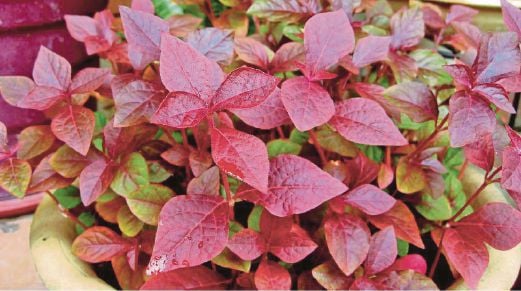

If you want textured ground cover, choose
the Purple Hookweed, writes Stephanie Choo
PURPLE hookweed, a variety of the species Cyathula prostrata, transforms bare sunny areas into a leafy textured tapestry. It makes great ground cover and can be used to form patterns to flow through the landscape.
useful plant
Generally known as prostrate pastureweed or nyarang in Malay, Cyathula prostrata is widely distributed in the tropics, from Asia to Australia and China, including Southeast Asia. The plant species belongs to the family Amaranthaceae.
The herbaceous perennial grows to 30-50cm high. The oblong to rhomboid green leaves, usually 2-3cm long, are simple and grow in opposite arrangement. The 20-30cm long spike bears one to three perfect flowers in lower clusters. The rest, up to 20 of them, are imperfect sterile flowers.
Considered a weed at forest margins, thickets, waste places and cultivated land, the Cyathula prostrata is in fact a useful plant. It possesses antiseptic, analgesic and antioxidant properties. Traditional healers use the plant to treat various illnesses that are mostly associated with inflammation and pain. In tropical west Africa, the leaves are consumed as a vegetable.
COLOUR-RICH VARIETIES
A variety that is very garden-worthy is the purple hookweed or purple princess. It bears gorgeous reddish purple-green leaves and has similar growth habit and form as a species. The more sunlight this low-growing shrub receives, the darker the leaves and flowers. There is also a variety of variegated yellow, red and green leaves. Another type, meanwhile, has green leaves with a red underside.
PLANTING VARIETY
The Purple Hookweed is the more popular variety and commands attention even when grown singular or mixed, although it is often grown en masse. Mass planting of the shrub forms a lush reddish foliage that blankets the ground and the result is a stunning shrubby ground cover or border. The technique can also be used to spruce up locations along paths.
When purple hookweed is used in masses of contrasting or harmonious colours, a pattern is created in the garden. Since the shrub is petite, it is a great choice for smaller gardens. It makes a wonderful accent or as a singular plant in a pot.
The plant is also suitable for mixed plantings as foliage of various colours, forms and textures compose a more interesting landscape. Blend or soften it with green shrubs so that its red highlight gleams under the sun.
HOW TO GROW
The Purple Hookweed roots easily at the nodes. Take cuttings of about 12cm long to start new plants. Insert into well-draining fertile soil mix. Place the root cuttings under shelter initially. Once new growth appears, harden off the young plants before transplanting.
It thrives in both full sun and partial sun. The fast-growing plant flourishes with great ease in our climate. Water daily to keep soil moist at all times.
Feed lightly with any balanced fertiliser fortnightly. Prune regularly for denser growth to prevent the tiny whitish flowers from setting seeds and to also control its size.
TIP
The leaves may take on a different shade of red or purple-green in different places. Move the plant to a suitable spot for the leaves to colour evenly.
When using the plant in mass planting, narrow the gap between plants to hasten the covering of the ground. Initially, it is necessary to weed regularly.
This colourful shrub is a good alternative to turf grass if you intend to cover an empty patch that has no foot traffic. Also it only requires simple maintenance.